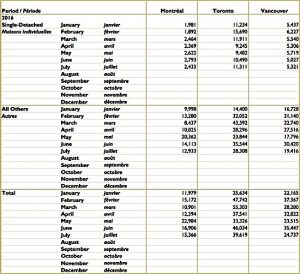Last month’s surge is this month’s drop in the endlessly rolling sea that is Canada’s new homes market. In June, housing starts were up at an annualized rate of 17% compared to the previous month; in July, starts are down by almost exactly the same amount, 16.3%. The drop in July was less than economists had expected. According to Canada Mortgage and Housing Corporation, which always emphasises the six-month trend measure rather than the standalone monthly seasonally adjusted annual rates (SAAR), Canadian housing starts trended upwards in July. The upward trend shows continued strength in BC and Ontario’s condominium segment, CMHC says, and reflects “strong demand for lower-priced homes and low inventories of completed and unsold new units.”
It can be a little confusing keeping the trend numbers and the standalone numbers clear. In Toronto, for example, the trend measure was firmly up: 43,261 units in July, 40,930 in June. A CMHC analyst, Dana Senagama, commented that the trend increase was “fuelled by condo apartment construction.” Single-detached home starts also continued to trend strongly in July, with strong sales in that market and limited resale listings for buyers to choose from.
However, the standalone numbers for Toronto in July were down 13.9%t, “mainly as a result of fewer apartment starts.”
So while the six-month trend shows upward movement, propelled by increased construction in the condominium segment, the annualised number for the month is down, the result of fewer condominium starts compared to the previous month. That said, the highest number of starts in the GTA was in the City of Toronto, again, mainly due to condominium starts.
Provincially, once again the trend line is moving up, while the SAAR line moved down. The total number of urban housing starts dropped from 84,784 units in June to 72,594 in July, a decline of 14.3%. Both condominium and purpose-built rental construction remained “elevated” in Ontario, CMHC says, as declining affordability, less choice in the resale market and low rental vacancy rates support higher density residential construction investment.
Over half of Ontario urban centres posted decreases in housing starts in July. Hamilton is one city where both the trend line and the SAAR are in sync and rising. Hamilton is having something of a housing boom, particularly in the townhouse and condo segment. CMHC says the increase in these types of housing reflects a shift in demand to the more affordable multi-unit housing as single-detached homes become increasingly unaffordable. How much of that price pressure on Hamilton’s single-detached home stock comes from displaced Torontonians is not fully understood yet, but there are indications it is substantial.
Across the province, housing starts are actually up 19% compared to the same time last year. The July data overall show that housing starts and construction rest on a firm foundation that is tied to population growth and demand, noted CIBC Capital Markets economist Avery Shenfeld.
Canada Housing Starts in July Reflect Demographic Demand by Josephine Nolan | Condo.ca



Recent Comments